
Blowing a raspberry, razzing or making a Bronx cheer, is to make a noise similar to flatulence that may signify derision, real or feigned. It is made by placing the tongue between the lips, or alternately placing the lips against any area of skin, and blowing. When performed against the skin of another person, it is often a form of tickling.

Donald Gets Drafted is a 1942 American animated short film produced by Walt Disney Productions and released by RKO Radio Pictures. The cartoon has Donald Duck being drafted into the U. S. Army during World War II and follows his introduction to military life. The film was directed by Jack King and introduced the song "The Army's Not the Army Anymore" by Carl Barks and Leigh Harline. The voice cast includes Clarence Nash as Donald, John McLeish as an officer, and Billy Bletcher as Pete who is Donald's drill sergeant.
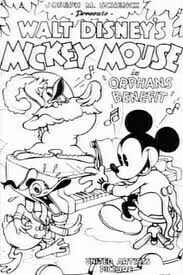
Orphan's Benefit is an American animated short film produced by Walt Disney Productions in black-and-white. It was first released in 1934 and was later remade in Technicolor in 1941 under the corrected title Orphans' Benefit. The cartoon features Mickey Mouse and his friends putting on a vaudeville-style benefit show for a group of unruly orphans. It contains a number of firsts for Disney, including the first time in which Mickey Mouse and Donald Duck appear together, and was the 68th Mickey Mouse short film to be released, and the sixth of that year. It was also the cartoon which had the first story to be written that featured Donald Duck, though it was the second Donald Duck short to be produced and released, after The Wise Little Hen.

Education for Death: The Making of the Nazi is an American animated propaganda short film produced by Walt Disney Productions and released on January 15, 1943, by RKO Radio Pictures, shown in theaters with Fighting Frontier. The film is directed by Clyde Geronimi and principally animated by Milt Kahl, Ward Kimball, Frank Thomas, and Bill Tytla. The short is based on the non-fiction book of the same name by American author Gregor Ziemer. The film features the story of Hans, a boy born and raised in Nazi Germany, his indoctrination in the Hitlerjugend, and his eventual march to war.
John Ryan Kinney was an American animator, director and producer of animated shorts. Kinney is the older brother of fellow Disney animator Dick Kinney.
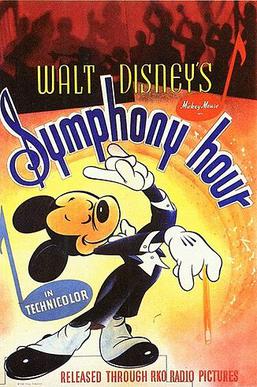
Symphony Hour is a 1942 American animated short film produced by Walt Disney Productions and released by RKO Radio Pictures. The cartoon depicts Mickey Mouse conducting a symphony orchestra sponsored by Pete. The film was directed by Riley Thomson and features music adapted from the "Light Cavalry Overture" by Franz von Suppé. The voice cast includes Walt Disney as Mickey, Billy Bletcher as Pete, and John McLeish as a radio announcer. It was the 117th short in the Mickey Mouse film series to be released, and the second for that year.

The Spirit of '43 is an American animated World War II propaganda film created by Walt Disney Studios and released in January 1943. The film stars Donald Duck and features writer/designer Carl Barks' prototype for the character Scrooge McDuck. It is a sequel to The New Spirit. The purpose of the film is to encourage patriotic Americans to file and pay their income taxes faithfully in order to help the war effort. The repeated theme in the film is "Taxes... To Defeat the Axis".

Russian Rhapsody is a 1944 Warner Bros. Merrie Melodies cartoon directed by Bob Clampett. The short was released on May 20, 1944.

The New Spirit is a 1942 American animated short film produced by Walt Disney Productions and the U.S. Department of the Treasury, and released by the War Activities Committee of the Motion Pictures Industry. The cartoon, which stars Donald Duck, was the first film created as part of Walt Disney's World War II propaganda production. It was commissioned by Henry Morgenthau Jr., then Secretary of the Treasury, to encourage American citizens to pay their income tax in support of the war effort. The film was directed by Wilfred Jackson and Ben Sharpsteen, and features Clarence Nash as the voice of Donald, Fred Shields as the radio announcer, and Cliff Edwards singing the theme song.
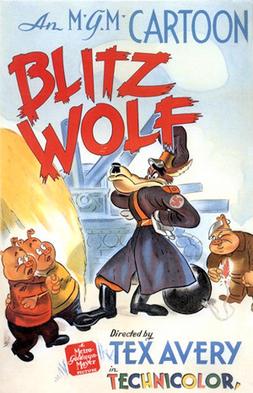
Blitz Wolf is a 1942 American animated propaganda short film produced and distributed by Metro-Goldwyn-Mayer. A parody of the Three Little Pigs told via a World War II perspective, the short was directed by Tex Avery and produced by Fred Quimby. It was nominated for the Academy Award for Best Short Subject: Cartoons but lost to Der Fuehrer's Face, another anti-Nazi World War II parody featuring Donald Duck.

Scrap Happy Daffy is a 1943 Warner Bros. Looney Tunes short directed by Frank Tashlin. The cartoon was released on August 21, 1943, and stars Daffy Duck.
The third wave of Walt Disney Treasures was released on May 18, 2004. It was originally planned to be released in December 2003, but was delayed for almost half a year in order to meet an increased demand with a higher number of tins produced. This wave was the first to have a certificate of authenticity with the individual number of the tin on it, replacing the number embossed on the tin. This was the final wave released with side straps.
The fifth wave of Walt Disney Treasures was released on December 6, 2005. Starting with this wave the DVD cases are now single opening, but the same size as the previous.
Between 1941 and 1945, during World War II, Walt Disney was involved in the production of propaganda films for the U.S. government. The widespread familiarity of Disney's productions benefited the U.S. government in producing pro-American war propaganda in an effort to increase support for the war.
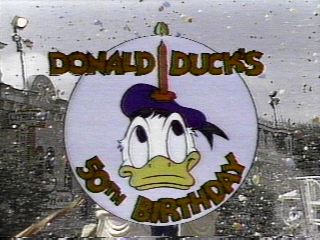
Donald Duck's 50th Birthday is a television special broadcast on The Magical World of Disney on November 13, 1984 on CBS. As the title suggests, it was produced to celebrate the 50th anniversary of the Donald Duck character, who first appeared in the Walt Disney short The Wise Little Hen in 1934.
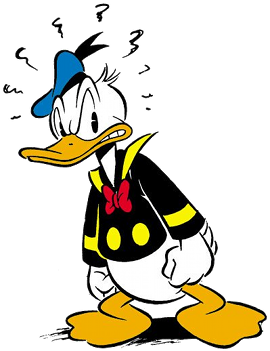
Donald Duck is a cartoon character created by The Walt Disney Company. Donald is an anthropomorphic white duck with a yellow-orange bill, legs, and feet. He typically wears a sailor shirt and cap with a bow tie. Donald is known for his semi-intelligible speech and his mischievous, temperamental, and pompous personality. Along with his friend Mickey Mouse, Donald was included in TV Guide's list of the 50 greatest cartoon characters of all time in 2002, and has earned a star on the Hollywood Walk of Fame. He has appeared in more films than any other Disney character.
World War II changed the possibilities for animation. Prior to the war, animation was mostly seen as a form of family entertainment. The attack on Pearl Harbor was a turning point in its utility. On December 8, 1941, the United States Army began working with Walt Disney at his studio, stationing Military personnel there for the duration of the war. The Army and Disney set about making various types of films for several different audiences. Most films meant for the public included some type of propaganda, while films for the troops included training and education about a given topic.
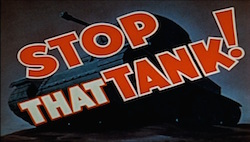
Stop That Tank! is a 22-minute 1942 instructional film created during World War II by Walt Disney Productions for the Directorate of Military Training, The Department of National Defence and the National Film Board of Canada (NFB). Its purpose, akin to "edutainment", was to instruct Canadian soldiers in the handling and care of the Boys Mk.1 Anti-tank rifle for use in combat against Nazi tanks. The film presented information in an entertaining manner as well as providing an anti-Nazi propaganda message.

Donald's Decision is a four-minute educational short animated film made by the Walt Disney Studios, for the National Film Board of Canada. The film was released theatrically on January 11, 1942 as part of a series of four films directed at the Canadian public to buy war bonds during the Second World War.
Events in 1943 in animation.

![Donald "heil[s] right in Der Fuehrer's face". Ducknazi.jpg](http://upload.wikimedia.org/wikipedia/en/thumb/c/c3/Ducknazi.jpg/200px-Ducknazi.jpg)















